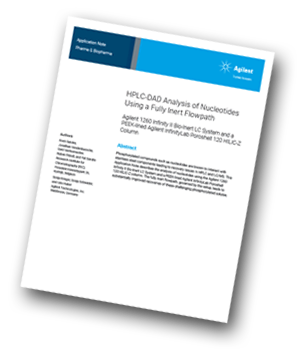Phosphorylated compounds such as nucleotides are known to interact with stainless steel components leading to recovery issues in HPLC and LC/MS. Instrument and column inertness ensure successful analysis. Discover more about the bio-inert analysis of nucleotides in this application note from Agilent.

 This application note describes the analysis of nucleotides using the Agilent 1260 Infinity II Bio-Inert LC System and a PEEK-lined Agilent InfinityLab Poroshell 120 HILIC-Z column. The fully inert flowpath, governed by the setup, leads to substantially improved recoveries of these challenging phosphorylated solutes.
This application note describes the analysis of nucleotides using the Agilent 1260 Infinity II Bio-Inert LC System and a PEEK-lined Agilent InfinityLab Poroshell 120 HILIC-Z column. The fully inert flowpath, governed by the setup, leads to substantially improved recoveries of these challenging phosphorylated solutes.
The chromatographic analysis of phosphorylated species is highly challenging. Interaction between phosphate groups and stainless steel components in the flowpath leads to peak broadening and peak loss. This phenomenon has been described for phosphorylated peptides, phosphosugars, and nucleotides, among others. Phosphorylated glycans can successfully be analyzed when the entire sample flowpath is metal-free. To achieve this, an Agilent 1260 Infinity II Bio-Inert LC System and a PEEK-lined HILIC column were used.
The application note demonstrates that these challenging phosphorylated structures can successfully be analyzed when the entire flowpath is devoid of metal parts, that is, with instrument and column inertness.




